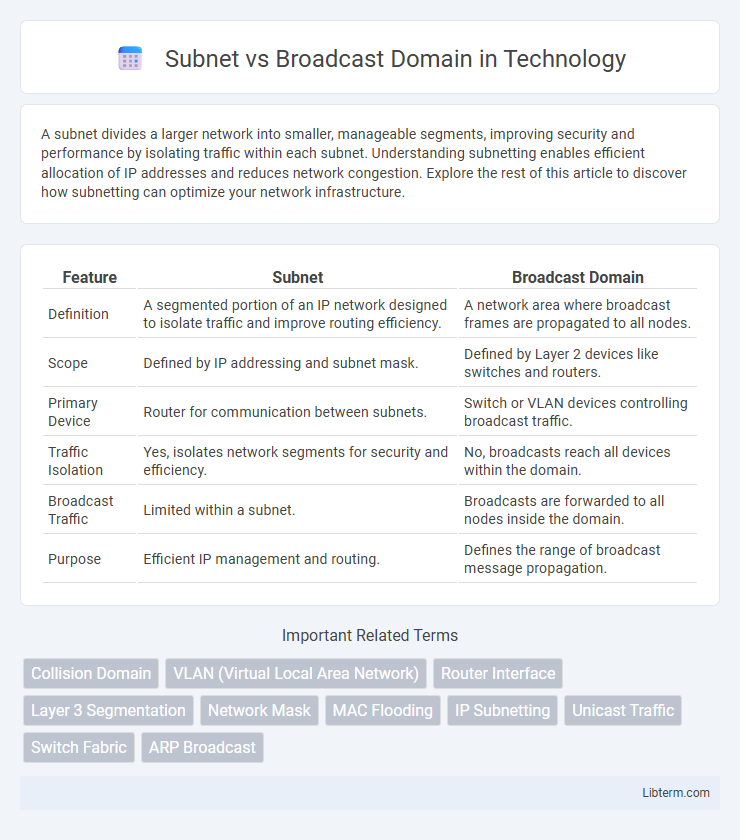A subnet divides a larger network into smaller, manageable segments, improving security and performance by isolating traffic within each subnet. Understanding subnetting enables efficient allocation of IP addresses and reduces network congestion. Explore the rest of this article to discover how subnetting can optimize your network infrastructure.
Table of Comparison
| Feature | Subnet | Broadcast Domain |
|---|---|---|
| Definition | A segmented portion of an IP network designed to isolate traffic and improve routing efficiency. | A network area where broadcast frames are propagated to all nodes. |
| Scope | Defined by IP addressing and subnet mask. | Defined by Layer 2 devices like switches and routers. |
| Primary Device | Router for communication between subnets. | Switch or VLAN devices controlling broadcast traffic. |
| Traffic Isolation | Yes, isolates network segments for security and efficiency. | No, broadcasts reach all devices within the domain. |
| Broadcast Traffic | Limited within a subnet. | Broadcasts are forwarded to all nodes inside the domain. |
| Purpose | Efficient IP management and routing. | Defines the range of broadcast message propagation. |
Introduction to Subnets and Broadcast Domains
Subnets divide a larger network into smaller, manageable segments by assigning unique subnet masks, improving traffic management and security within an IP network. A broadcast domain is a logical area where any broadcast packet sent by a device reaches all other devices within the same domain, typically limited by routers. Understanding the distinction between subnets and broadcast domains is essential for efficient network design and minimizing broadcast traffic.
Defining Subnet: Concepts and Purpose
A subnet, short for subnetwork, is a segmented portion of a larger IP network that divides the network into multiple smaller, manageable sections. Each subnet operates within its own range of IP addresses, defined by a subnet mask, which determines the network and host portions of the address. Subnetting improves network performance and security by isolating traffic within subnets and reducing broadcast domain size, minimizing unnecessary data transmission.
Broadcast Domain: Meaning and Significance
A broadcast domain is the logical division of a network where any broadcast sent by a device is received by all other devices within the same segment, typically bounded by routers or layer 3 devices. It plays a critical role in network performance and traffic management, as excessive broadcasts can lead to network congestion and collision domains. Understanding the boundaries of a broadcast domain aids in designing efficient, scalable networks by segmenting traffic and reducing unnecessary broadcast overhead.
Key Differences Between Subnet and Broadcast Domain
A subnet is a segmented portion of an IP network that groups devices for efficient routing, defined by a subnet mask, while a broadcast domain is a logical area where broadcast frames are forwarded, limited by devices like routers. Subnets are primarily used to organize and manage IP addresses, enhancing network performance and security, whereas broadcast domains determine the scope of broadcast traffic within the network. Understanding these distinctions is crucial for network design, as subnets control address allocation, and broadcast domains impact traffic congestion and collision domains.
How Subnets Affect Network Segmentation
Subnets play a crucial role in network segmentation by dividing a larger network into smaller, manageable subnetworks, which improves traffic management and enhances security by isolating broadcast domains. Each subnet functions as a distinct broadcast domain, limiting broadcast traffic to devices within the same subnet and reducing network congestion. This segmentation facilitates more efficient IP address allocation and simplifies troubleshooting within complex network environments.
Role of Broadcast Domains in Network Communication
A broadcast domain defines the network segment where a broadcast frame is forwarded to all devices, enabling efficient communication within local networks. Subnets segment IP address ranges but broadcast domains determine the reach of broadcast traffic, directly impacting network traffic and collision domains. Managing broadcast domains through routers or VLANs reduces unnecessary traffic and enhances overall network performance and security.
Common Use Cases for Subnets and Broadcast Domains
Subnets are commonly used to segment large networks into smaller, manageable units, improving network performance and enhancing security by limiting broadcast traffic to specific segments. Broadcast domains define the set of devices that receive broadcast frames, typically constrained within a single subnet to reduce unnecessary network congestion. In enterprise environments, subnets isolate departments or user groups, while broadcast domains control the scope of broadcast traffic to prevent excessive network loads and ensure efficient communication.
Advantages of Subnetting vs. Managing Broadcast Domains
Subnetting improves network performance by dividing a large network into smaller, manageable segments, reducing broadcast traffic within each subnet and minimizing collision domains. It enhances security and simplifies troubleshooting by isolating network issues to specific subnets, whereas managing broadcast domains without subnetting can lead to excessive broadcast traffic and network congestion. Efficient subnetting optimizes IP address allocation, enabling better control over network resources and scalability compared to handling broad broadcast domains.
Best Practices for Optimizing Subnets and Broadcast Domains
Segmenting a network into smaller subnets minimizes the size of broadcast domains, reducing unnecessary traffic and improving overall performance. Best practices include assigning subnet masks that balance efficient IP address allocation with limiting broadcast domain size, typically by using Variable Length Subnet Masking (VLSM). Implementing VLANs further isolates broadcast domains, enhancing security and reducing congestion within each subnet.
Conclusion: Choosing the Right Network Architecture
Selecting the appropriate network architecture depends on understanding the differences between subnetting and broadcast domains; subnetting segments a network to improve performance and security by creating multiple logical networks within a single IP space, while broadcast domains define the scope of broadcast traffic and limit collision domains. Effective network design requires balancing the benefits of subnetting to reduce broadcast traffic with the need to maintain efficient communication across devices within a broadcast domain. Optimizing network scalability, security, and traffic management ensures that subnetting and broadcast domain configurations align with organizational goals and technical requirements.
Subnet Infographic

 libterm.com
libterm.com